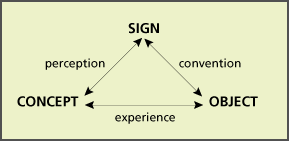
 TUTORIAL: SIGNS AND LANGUAGE
TUTORIAL: SIGNS AND LANGUAGEINTRODUCTION . ICON, INDEX AND SYMBOL . THE SEMIOTIC MODEL . DENOTATION AND CONNOTATION . PARADIGM AND SYNTAGM . ABSTRACTION . METAPHOR . METONYMY . MYTH
Most signs have at least one normal, "common sense" meaning. This meaning,
called the sign's denotation, is shared among many people and is the
most widely used meaning of the sign. But signs also may have many
different "subjective" meanings that arise from each individual's personal
experiences. These are called the connotations of the sign.
![]() 1001
1001
![]() 1003
1003
For example, most people would agree that the symbol #frog# refers to a tail-less, web-footed amphibious animal -- this is its denotation and is the meaning that is listed for the term in the dictionary. On the other hand, the connotations of #frog# depend on each person's individual experiences and might include such as memories of a dissection experiment in biology class, or a story about a frog read as a young child, or just the rather vague concept "ugggh."
Where do denotations come from? Why does the string of letters #frog#
denote an amphibian while the string #book# denotes a bound collection of
printed papers? Why does this symbol, ![]() , denote a male human
being, while
this one,
, denote a male human
being, while
this one, ![]() , denotes a female? Why does this symbol,
, denotes a female? Why does this symbol, ![]() , denote the presence of money, while this one,
, denote the presence of money, while this one, ![]() , denotes a question?
, denotes a question?
If each person made up his or her own denotation for every sign, people
would not be able to understand one another. Thus, while people do have
their own personal, connotative meanings for many signs, most signs have
at least one meaning that is shared in common. This notion of shared,
denotational meaning is one of the keys to understanding human
communication.
![]() 1024
1024
Thus, the denotation of a sign represents a agreement among a group of people that they will share that meaning of the sign among themselves. Meanings of this type are said to arise through social convention.
A sign may have more than one denotational meaning. In cases when a person
must choose one meaning from a number of options he or she looks to the
context of the sign to make the decision. For example, when seen
alone this icon ![]() usually denotes the human heart. But placed in
thiscontext:
usually denotes the human heart. But placed in
thiscontext: ![]() , its denotation becomes that of "love"
-- as in "I love you."
, its denotation becomes that of "love"
-- as in "I love you."
Conventional meanings change over time. In fact the conventional meanings of signs in a society are under continual renegotiation as new possible meanings arise, are considered, and are accepted or rejected.
Thus, each of the lines in the Semiotic Triangle

represents a two-way negotiation:
It is interesting to compare this model to the semiotic model. Although they both focus on how human communication becomes meaningful, their approaches are very different.